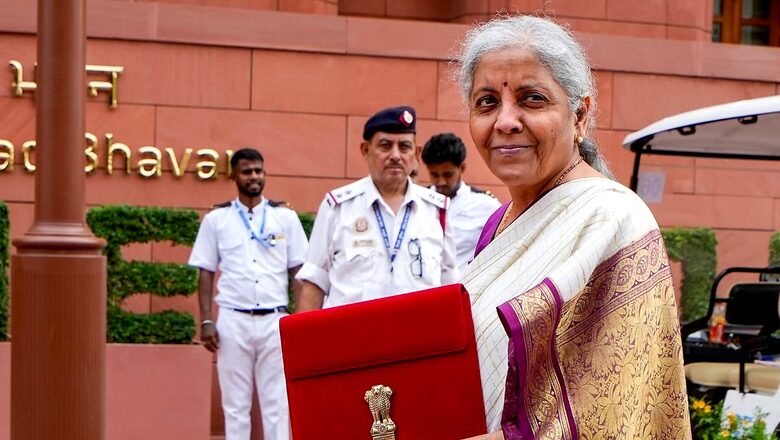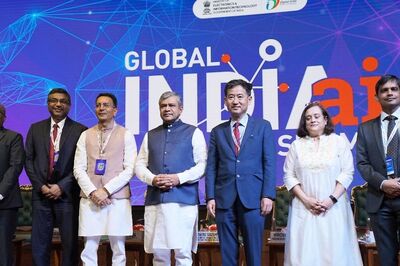
views
In concluding Part III of the budget special series, I take off from Part I and Part II. In this part, I focus on the areas not touched upon so far.
One, critical actions taken or not taken to increase consumption. This is particularly important because recent GDP growth has much to do with heavy lifting by the government in terms of capital expenditure, while private sector capex is on holiday and rural and urban consumption has been limping back after the Covid-19 onslaught.
Two, budgetary foundational priorities and headline areas not covered so far—more particularly agriculture and rural development, MSME focus, energy security, and the innovation ecosystem.
Three, critical areas that need a transformative increase in outlay, along with structural reforms, to make India viksit. However, these areas continue to receive step-motherly treatment.
Four, I end with a special mention of the forgotten section of society whose historical neglect continues in this budget as well—these are the people with special needs: the infirm, the disabled, the mentally ill, and the fast-increasing geriatric population. India will soon be home to the world’s second-largest population of senior citizens.
Consumption Conundrum
India’s recent growth story has been largely driven by significant government investment, a level of capital spending not previously seen from Central and state governments. Public sector enterprises have also recently joined the party, accelerating their expenditure in the current fiscal year. However, private sector corporations have largely been on a capex holiday despite record pre-tax profits. They must now take the baton if India’s growth story is to reach its full potential.
This shift is crucial because consumption growth has been highly uneven in the post-pandemic period. Rural households are still recovering from deep economic trauma, further exacerbated by rising food inflation. A recent Morgan Stanley report indicates some green shoots in private consumption, with the last four quarters (ending December 2023) showing 3.5 per cent growth compared to 1.8 per cent in December 2022. However, it remains worrisome that consumption is still below pre-pandemic levels.
The budget includes a few direct and indirect measures to drive consumption: free ration for 81 crore people, a significant outlay for agriculture and the rural sector, employment generation prioritisation, MSME focus and a Rs 11.11 lakh crore capex. The free ration scheme introduced in the wake of disruption, mass-scale suffering and unprecedented reverse migration to rural areas owing to Covid-19 pandemic, has saved millions from hunger and malnutrition, but there remains an urgent open question- how India can become viksit with 60 per cent population surviving on free ration?
There is a strong case for increasing the allocation for MGNREGA beyond the current Rs 86,000 crore, along with a necessary overhaul of the MGNREGA wage structure. Additionally, the private sector must significantly increase its capital expenditure in conjunction with government investments. Also, the private sector seeing record profit requires urgent wage enhancement of entry-level staff. This, along with other measures, could boost urban expenditure, if inflation remains under control and the private sector wage structure undergoes the much-needed upward revision.
Consumption Driven Economy
India’s richest 1 per cent hold 40 per cent of the nation’s wealth, a significant increase from 16.1 per cent in 1991. Despite this disparity and the barring of the Covid disruption, India’s growth story since the 1991 liberalisation has largely been consumption-driven. This marks the emergence of a new Indian economy, transitioning from a past supply-constrained nation to a demand-constrained one.
For India to achieve viksit status, income must reach the hands of the poor, lower, and middle-income Bharatiyas. It is this additional surplus money in their hands that will fuel the consumption channel and spur consumption-driven growth. As recent ORF research rightly outlines, “India’s policy response needs to be ‘Keynesian’—greater wealth taxation to channel resources towards social goals. This needs to be complemented by economic empowerment at the grassroots level by revitalising social security schemes targeted at income generation for lower-income groups.”
To this end, FY2024-25 is at best a work in progress. The changes in the financial market tax structure and the removal of indexation in real estate transactions should be seen as positive steps, despite the intra-day wild fluctuations in the stock market on budget day.
Before addressing the remaining key budget priority areas not discussed so far, I will focus on two critical areas that should have received much greater attention and higher allocation than they currently have.
Health Disrupted
The health sector is a perennial whipping boy in the annual budgets, consistently failing to receive the funding it deserves. This stems from the fact that Public Health and Sanitation, along with Hospitals and Dispensaries, are listed in the State List of the Seventh Schedule. Consequently, the Union government expects states —many of which lack resources—to bear the primary responsibility.
In this game of one-upmanship, it is the common man who suffers immeasurably. With neither the Centre nor the states spending enough, the main burden falls on families, pushing millions into absolute poverty. The combined central and state healthcare expenditure is a pittance – a mere 2.1 per cent of GDP in FY23, 2.2 per cent in FY22, and 1.6 per cent in FY21. By contrast, China’s health expenditure in 2022 was 7.05 per cent of GDP, up from 6.7 per cent in 2021, according to the Statista database.
According to the latest National Health Accounts (NHA) estimates (2019–20), out-of-pocket expenses for families on health are disturbingly high at 47.1 per cent. This figure reaches disastrous levels in many states, including but not limited to: Uttar Pradesh (71.3 per cent), Kerala (68.6 per cent), Jharkhand (63.9 per cent), Andhra Pradesh (63.2 per cent), Bihar (53.5 per cent), Madhya Pradesh (55.7 per cent), Odisha (53.2 per cent), Punjab (65.5 per cent), and West Bengal (68.7 per cent).
I examined FM Sitharaman’s budget closely to find a solution to the current sorry state and was not particularly pleased with what I discovered. Despite her significant promises in the interim budget, the healthcare budget outlay remains largely unchanged—Rs 87,656 crore for the year 2024-25, a marginal increase of 1.7 per cent. Except for an increase in the allocation for the National Health Mission (NHM), which rose to Rs 36,000 crore from Rs 29,000 crore last year, and Ayushman Bharat health insurance scheme, which provides a cover of Rs 5 lakh to the poorest 40 per cent of the country (increased to Rs 7,300 crore from Rs 7,200 crore last year), most areas of the outlay are either static or have decreased.
The health sector needs to be rebooted. Two critical reform imperatives are: increasing the health sector outlay to 5 per cent of GDP and pursuing a bipartisan constitutional amendment to bring public health, hospitals, and dispensaries into the Concurrent List. Finance Minister Sitharaman must not wait for the next budget to act. Additionally, there are two neglected areas of the healthcare regime—geriatric healthcare and mental healthcare—which I will address later.
Broken Education System
India’s education system is broken beyond redemption. While healthcare needs rebooting, the education system requires complete demolition and reconstruction, with or without the New Education Policy unveiled in 2022, which aims to make Bharat a global knowledge superpower.
What ails the education sector is beyond the scope of this article. Suffice it to say that the rot permeates every stage—primary, secondary, and higher education, as well as infrastructure, curriculum, and examination systems. Worse, Bharat lacks teachers who can transform it into a knowledge superpower.
Can Sitharaman’s budget fix the broken education system? I say an informed no. A lot more is needed. It is time for a complete overhaul of the education sector. Here is why:
At face value, the Rs 1.20 lakh crore allocated for the education sector in the FY24-25 budget represents an increase of Rs 7,728 crore over the budget estimate (BE) for 2023-24, marking a nearly 6.62 per cent rise from Rs 1,12,899 crore. However, the positive news ends here, as the allocated amount for FY25 is Rs 9,091 crore less than the revised estimate for 2023-24 and translates to a nearly 7.26 per cent decline compared with the previous revised estimates of Rs 1,29,718 crore. Additionally, compared to the FY23-24 budget estimate, the allocation for schools is up by a mere 4.2 per cent, and higher education by 7.68 per cent.
Unless the situation improves radically and swiftly, India’s much-vaunted “demographic dividend” will soon transform into a “demographic curse.” The combined central and state education sector outlay equals a meagre 3 per cent of GDP, falling short of the minimum required 6 per cent.
The onus now falls on FM Sitharaman to make mid-course corrections without waiting for the FY26 budget. Unlike the health sector, there are no constitutional constraints restricting the Centre. While the nation may look back in shame at many of Indira Gandhi’s actions during the Emergency, the 42nd Amendment Act of 1976 did enact one noble change: transferring Education from the State List to the Concurrent List.
The Upswing – Agriculture and Rural Development
Indisputably, the ruling coalition faced the ignominy of anger (perceived or real) from two of its four key demographics in the general election: youth and farmers. It is unsurprising, then, that both have found special attention in the budget. The combined budgetary outlay for the rural sector, at Rs 4.18 lakh crore, is second only to defence (Rs 6.21 lakh crore) and transport (Rs 5.47 lakh crore). This includes an allocation of Rs 1.52 crore for agriculture and allied sectors and Rs 2.66 crore for rural development, including rural infrastructure. This is laudable.
However, beyond budgetary allocations, the budget aims to transform the agriculture sector through multiple new initiatives:
- Prioritising next-generation research with a heightened focus on boosting productivity and developing climate-resilient varieties. This will involve the inclusion of outside domain experts and the private sector.
- Releasing 109 new high-yielding and climate-resilient varieties of 32 field crops and horticultural crops for cultivation by farmers.
- Promoting natural farming by initiating 1 crore farmers into it over the next two years, supported by certification, branding, and implementation through scientific institutions and willing gram panchayats.
- Achieving self-sufficiency in pulses and oilseeds by strengthening production, storage, and marketing of key oilseeds such as mustard, groundnut, sesame, soybean, and sunflower.
- Developing large-scale clusters near consumption centres to enhance vegetable production and supply chains, with the support of Farmer-Producer Organizations, cooperatives, and start-ups for collection, storage, and marketing.
- Introducing a new national cooperative policy, which has been overdue for the past seventy-seven years.
- Mainstreaming digital public infrastructure for agriculture (following the success of the pilot project) within a fixed time frame of three years and implementing rural land reform measures (discussed in detail in Part II of this series).
Other Priority Areas
One, Inclusive Human Resource Development and Social Justice: The provisions in this area are nebulous and semantic, failing to provide a concrete pathway for action. While it’s hoped greater clarity and action will emerge in the future, one silver lining is the Pradhan Mantri Janjatiya Unnat Gram Abhiyan, which aims to benefit five crore tribal people through saturation coverage in 63,000 villages. This initiative is commendable.
Two, Manufacturing and Services: The newfound focus on MSMEs is welcome. Their struggles were exacerbated by the triple whammy of demonetisation, the introduction of GST, and Covid-19. If India is to become a manufacturing hub and a global services superpower, it must prioritise the advancement of MSMEs, which are currently stuck in the middle and have significant potential for employment generation. The current budget offers some good measures for MSMEs, but much more needs to be done.
Regarding E-Commerce Export Hubs and Industrial Parks, the Central government should act as an enabler, allowing states and the private sector to shoulder the heavy lifting. The critical mining mission, including offshore mining, the application of digital public infrastructure, and further reforms of the Insolvency and Bankruptcy Code (IBC) are welcome developments, but the devil lies in the urgency, rigour, and robustness of their implementation.
Three, Energy Security: Despite the prime minister’s public pronouncements at COP26 (achieving net-zero emissions by 2070) and the Delhi Declaration of the G20 (achieving net-zero emissions by 2050), a clear roadmap to achieve these goals is still lacking. While India has made significant strides in ensuring power access for all, including villages, the journey to a sustainable energy future is far from over. A policy document outlining appropriate energy transition pathways that balance the imperatives of employment, growth, and environmental sustainability is welcome. However, the key lies in concurrent action. The path is bumpy but there are low-hanging fruits as well.
The budget should have included policies to promote pumped storage projects for electricity storage, facilitate the smooth integration of renewable energy into the overall energy mix, and address the challenges of its variable and intermittent nature. Unfortunately, India’s dependence on polluting fossil fuels and thermal plants will continue if the nation is to achieve viksit status. A clear pathway to navigate this trade-off needs to be articulated and implemented.
Four, Innovation, Research & Development: This is the most urgent priority for Viksit Bharat. Although India was ranked 7th in the world for resident patent filing activity according to the WIPO Report 2022, it still lags behind at 40th position in the Global Innovation Index (GII) 2023, despite being on track to become the third-largest economy globally.
I appreciate the operationalisation of the Anusandhan National Research Fund for basic research and prototype development, along with plans to establish a mechanism for fostering private sector-driven research and innovation at a commercial scale, backed by a Rs 1 lakh crore financing pool. However, a cursory look at the inter-sectoral budget allocations raises concerns about whether our R&D efforts are truly cutting-edge. If we are to improve our position in the innovation index, the current allocations must keep pace with the growing needs.
The End as the Beginning
I end with three issues that have been neglected by every finance minister for the past 77 years. These should be the first three priorities, indeed, pillars, of FM Sitharaman’s FY26 Budget:
One, Geriatric Focus: India’s current elderly population of 153 million (aged 60 and above) is already sizeable. Their needs, including Medicare, are vastly different. The elderly population is expected to reach a staggering 347 million by 2050, surpassing the total population of America. This demographic shift is not just a statistic; it represents a societal transformation of unparalleled magnitude with far-reaching implications. Also, it is time for the corporate sector to look at this population as a special market niche. India urgently needs a dedicated Ministry to take swift action.
Two, Mental Health Imperative: The Economic Survey had raised my hopes to a level of irrational exuberance by focusing on the finer details of mental health and mental healthcare. After serving as a Member of the GoI Mental Health Policy Group for four years and being a member of the First GoI Central Mental Health Authority, I am dismayed by the complete lack of focus in the budget. Tele mental health is a road to nowhere for addressing serious mental health issues. When will Bharat wake up? It is time for immediate corrective action! The way forward is to establish a dedicated Department of Mental Health, headed by a capable and compassionate secretary and an exclusive Minister of State.
After countless hours debating this on television and having written extensively on the subject since 2010, I have nothing more to add. As a sick, old, and tired person suffering from an incurable mental illness, I know this is a pressing need. India has 20 crore Bharatiyas suffering from mental illness today. Worse, different states in India are at varying levels of mental healthcare development, with the lack of facilities amid growing incidence, severity, and stigma in eastern states bringing them closer to conditions seen in Sub-Saharan Africa.
Three, To End the Story, and Start a New Beginning: India is the world’s largest recipient of inward remittances, receiving a whopping $160 billion last year. China, the second-largest recipient, lags far behind. The populations of developed countries in the West, as well as Japan, Korea, and even China, are shrinking and ageing rapidly. This presents a unique opportunity for India. The time is ripe for a dedicated Emigration Facilitation Ministry. Let Indian youth swarm the world! Beyond boosting remittances and making Bharat prosperous, this move will serve as a bulwark against unemployment and prevent Indian youth from being caught in conflicts like the Russia-Ukraine war.
Concluded
The author is Multidisciplinary Thought Leader with Action Bias, India Based International Impact Consultant, and keen watcher of changing national and international scenario. He works as President Advisory Services of Consulting Company BARSYL. Views expressed in the above piece are personal and solely those of the author. They do not necessarily reflect News18’s views.



















Comments
0 comment